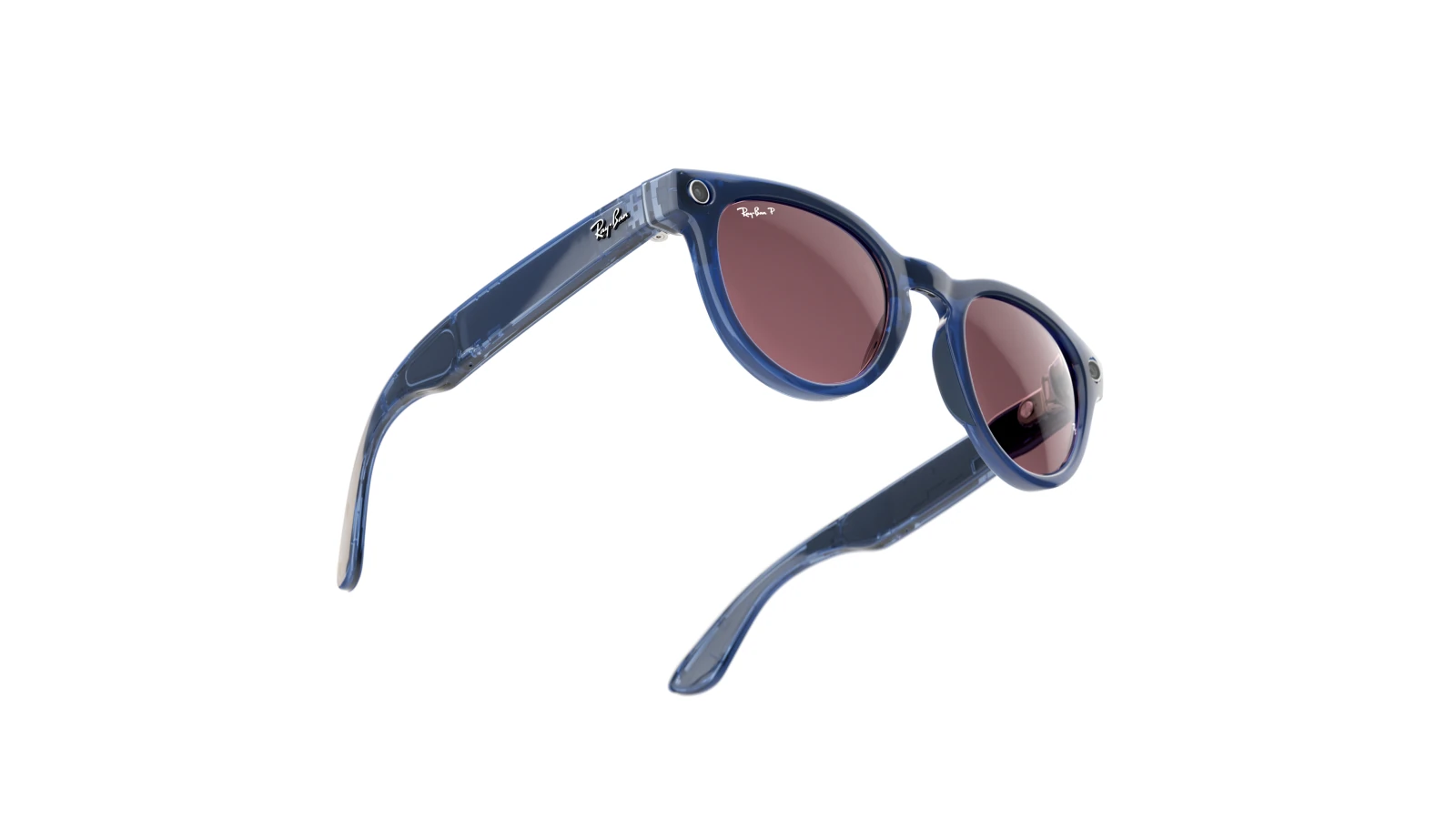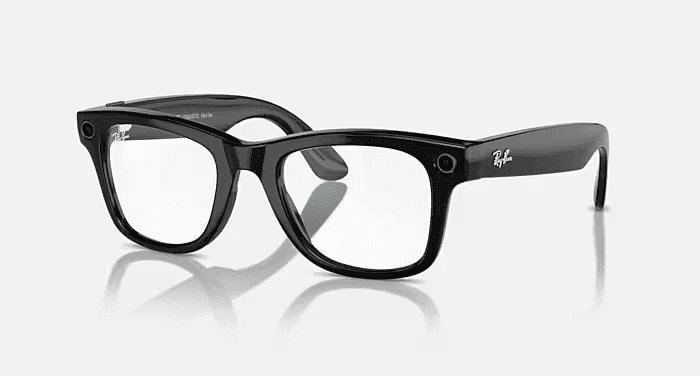
Meta is advancing smart glasses by integrating displays into its Ray-Ban eyewear, despite past skepticism and social stigmas. This innovation could transform wearable technology, addressing privacy and social acceptance challenges.
The integration aims to move smart glasses from niche gadgets to mainstream essentials and offers the potential for advanced augmented reality (AR) experiences. Users could receive digital information, such as directions and reviews, directly in their field of view, enhancing the interaction between the digital and physical worlds.
Meta’s Smart Glasses: The Future of Wearable Tech

Current Meta Smart Glasses
Meta currently offers smart glasses in partnership with Ray-Ban. These glasses can take photos and videos, play audio, and use a voice assistant. They are a first step towards more advanced wearable technology.
Rumors of Display Integration
Reports suggest Meta is working on adding small displays to their smart glasses. These displays would show information directly in the user’s field of view. This could include notifications, messages, or directions.
Why Add Displays?
- More Useful Features: Displays would make the glasses much more useful. Users could see information without taking out their phones.
- Competition: Other companies are also working on smart glasses with displays. Meta needs to keep up.
- Next Big Thing: Meta believes smart glasses could be the next major computing platform after smartphones.
What Kind of Displays?
The displays are expected to be small and discreet. They likely won’t cover the entire lens. Instead, they might show information in a corner of the user’s view.
When Could We See Them?
Some reports suggest these new glasses could arrive in the second half of 2025. However, this is just a rumor, and the release date could change.
Comparing Smart Glasses Features
Here’s a comparison of some key features in smart glasses:
| Feature | Current Meta Glasses | Future Meta Glasses (Rumored) | Other Smart Glasses |
|---|---|---|---|
| Camera | Yes | Likely Yes | Yes, in some models |
| Audio | Yes | Likely Yes | Yes, in most models |
| Voice Assistant | Yes | Likely Yes | Yes, in some models |
| Display | No | Rumored Yes | Yes, in some models |
What This Means for Users
If Meta adds displays to its smart glasses, it will be a big step forward. The glasses would become much more capable and could change how we interact with technology.
The Evolution of Wearable Technology
Wearable technology has been around for a while. Early examples include watches and fitness trackers. Now, we have smartwatches, smart glasses, and other wearable devices. These devices are becoming more powerful and can do more things. The addition of displays to smart glasses is a natural next step in this evolution. It allows for more complex interactions and provides users with a more immersive experience.
Short Summary:
- Meta aims to enhance its Ray-Ban smart glasses by incorporating displays for notifications and AI responses.
- The upgrade, expected by late 2025, leverages lessons from past smart glasses like Google Glass.
- Despite the innovative push, societal acceptance and privacy concerns continue to pose challenges for widespread adoption.
As technology evolves, so does the ambitious vision of smart glasses. Once synonymous with failure and public ridicule—thanks to the infamous Google Glass—this form factor is gaining renewed attention from industry giants like Meta. Mark Zuckerberg’s company has made considerable headway in this sector, establishing a partnership with Ray-Ban that has resulted in the popular Ray-Ban Meta glasses. However, these devices are currently devoid of displays, relying mainly on audio and voice interactions. A recent report from the Financial Times indicates that Meta plans to transform its smart glasses into a more versatile gadget by adding display capabilities by the end of 2025.
The convenience of incorporating a display into the Ray-Ban Meta glasses is an exciting prospect that might change the user experience fundamentally. According to sources familiar with the company’s strategy, these upgrades could enable users to view notifications as well as receive responses from Meta’s AI assistant. This shift is not merely a cosmetic update but a strategic move to enhance functionality as smart glasses seek to reclaim their place in consumer technology.
“In a connected world where seeing is believing, the integration of displays in smart glasses could redefine what we expect from wearable tech,” stated a prominent tech analyst.
The journey of smart glasses thus far has been far from smooth. The historical ineptitude of Google Glass, with its clunky design and negative stigma that branded users as “glassholes,” still serves as a cautionary tale for companies venturing into this territory. Despite the rapid advancements in technology, these brand associations are difficult to shake off. Meta’s Ray-Ban collaboration aims to bridge this gap by merging high-fashion aesthetics with modern technology. Selling well largely due to their attractive designs and decent audio performance, the current version of these glasses has garnered a following.
However, key limitations persist. As they currently stand, the Ray-Ban glasses do not boast any screen or display, leading many to view them as mere audio accessories rather than standalone devices. They enable users to play music, capture images, and make calls, yet they require the Meta View app for extended functionalities—a trait that undermines their perception as independent technological devices. As articulated by one reviewer: “The reality is that without a display, these glasses feel more like a smartphone adjunct rather than a sophisticated technological marvel.”
The Evolution of Smart Glasses
The proposal to incorporate small displays—akin to what was first conceptualized in Google Glass—could signify a critical modification in this narrative. Meta aims to devise a technology that allows users to access helpful information without having to navigate their smartphones constantly. This action reflects a substantial learning curve from earlier iterations, indicating an evolution in both consumer expectations and device capabilities.
“The addition of a display to Ray-Ban’s smart glasses represents a pivot towards functionality that may have been overlooked before, enabling features that could maximize everyday utility,” said tech industry expert Jane Doe.
While groundbreaking, it is important to acknowledge the drawbacks of integrating a display. Balance is crucial, particularly concerning weight and battery life. According to the reports from The Financial Times, Meta’s design strategy is focused on maintaining a lightweight feel for the eyewear, recognizing that excessive battery presence can lead to discomfort. The current iteration of VR headsets, such as the Quest Pro, faced significant complaints about subpar battery life, often leading to practical usability issues.
Addressing the Social Stigma
Amidst the technological advancements lie serious considerations about public perception and privacy issues associated with smart glasses. The concept of being able to record video or audio undetected raises alarms about social acceptability. Tech companies, including Meta, are aware that the activities of a few can affect the experience of the many. As evidenced by conversations on platforms like Reddit, many consumers express hesitance to adopt smart glasses due to concerns about privacy infringement.
“Using smart glasses feels intrusive, especially in public settings. I can’t imagine walking around with a camera strapped to my face,” wrote one Reddit user, voicing widespread apprehensions.
Despite these challenges, Meta’s ambition to redefine the smart glasses experience does not appear to be fleeting. Analysts predict that should Meta successfully implement a display, the momentum could invigorate demand, making smart glasses a desirable accessory rather than a source of ridicule. The potential to enter a new era of computing platforms, as articulated by Zuckerberg himself on Threads, could hinge on consumer acceptance and seamless integration within daily life.
Facing Stiff Competition
Indeed, competition is heating up in this space. Companies like Apple and Samsung are also exploring smart glasses development, aiming to create a more integrated ecosystem. Recent trends suggest that consumers may find greater appeal in technology that offers seamless experiences, especially when combined with existing devices like smartphones. In this rapidly evolving market, the company that successfully satisfies consumer demand for stylish, functional, and discreet smart eyewear stands to win.
“For Meta to stay competitive, it needs to innovate continually and present features that genuinely resonate with users’ lifestyles,” stated tech strategist John Smith.
Looking Forward
As excitement builds for potential future releases, industry experts are watching closely how Meta navigates the challenging landscape of smart wearables. The expected update in 2025 could usher in a new era, setting a precedent for other tech companies attempting to integrate displays into smart glasses effectively. Ultimately, whether the risk is worth the reward hinges not just on technological advancements but on shifting the public perception that continues to burden smart glasses.
The integration of displays in the Ray-Ban smart glasses could ultimately lay the foundation for exciting features such as augmented reality navigation, email previews, and more—all while bolstering the concept of wearable technology as the next major computing platform.
With all these elements combined, it’s clear that while the road ahead for smart glasses remains fraught with obstacles, the potential rewards may prove equally substantial, forever changing how we access information in our daily lives.





